steering wheel Oldsmobile Cutlass 1998 s User Guide
[x] Cancel search | Manufacturer: OLDSMOBILE, Model Year: 1998, Model line: Cutlass, Model: Oldsmobile Cutlass 1998Pages: 348, PDF Size: 17.46 MB
Page 159 of 348
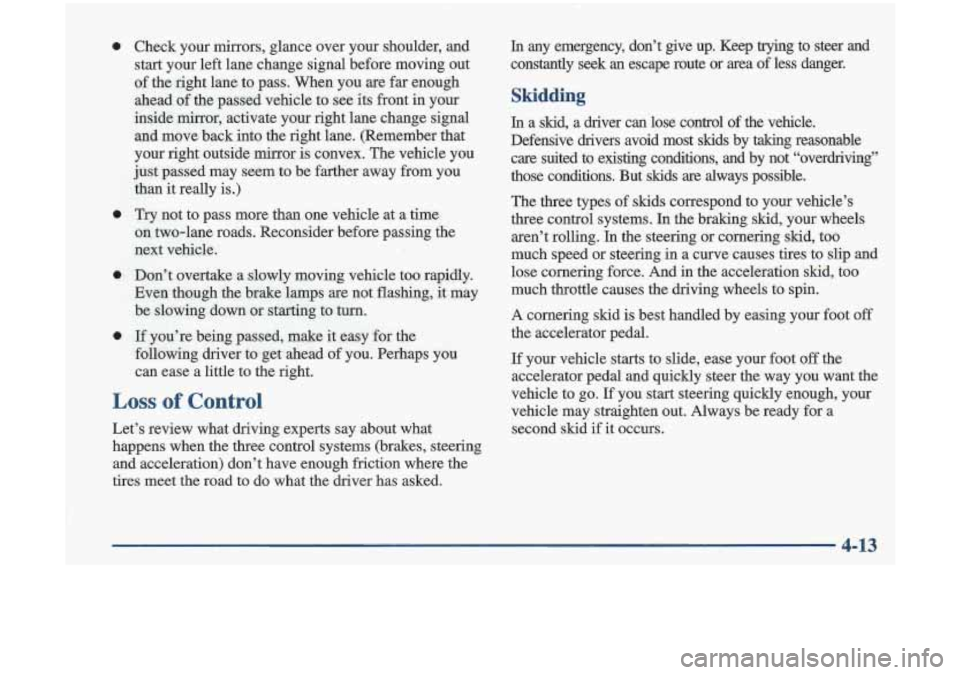
0 0
0
0
Loss of Control
Let’s review what driving experts say about what
happens when the three control systems (brakes, steering
and acceleration) don’t have enough friction where the
tires meet the road to do what the driver has asked.
In any emergency, don’t give up. Keep trylng to steer and
constantly
seek an escape route or area of less danger.
Skidding
In a skid, a driver can lose control of the vehicle.
Defensive drivers avoid most skids by taking reasonable care suited to existing conditions, and by not “overdriving”\
those conditions. But skids are always possible.
The three types of skids correspond to your vehicle’s
three control systems. In the braking skid, your wheels
aren’t rolling.
In the steering or cornering skid, too
much speed
or steering in a curve causes tires to slip and
lose cornering force. And
in the acceleration skid, too
much throttle causes the driving wheels to
spin.
A cornering skid is best handled by easing your foot off
the accelerator pedal.
If your vehicle starts to slide, ease your foot off the
accelerator pedal and quickly steer the way you want the
vehicle to go.
If you start steering quickly enough, your
vehicle may straighten out. Always be ready for a
second skid
if it occurs.
4-13
Page 174 of 348
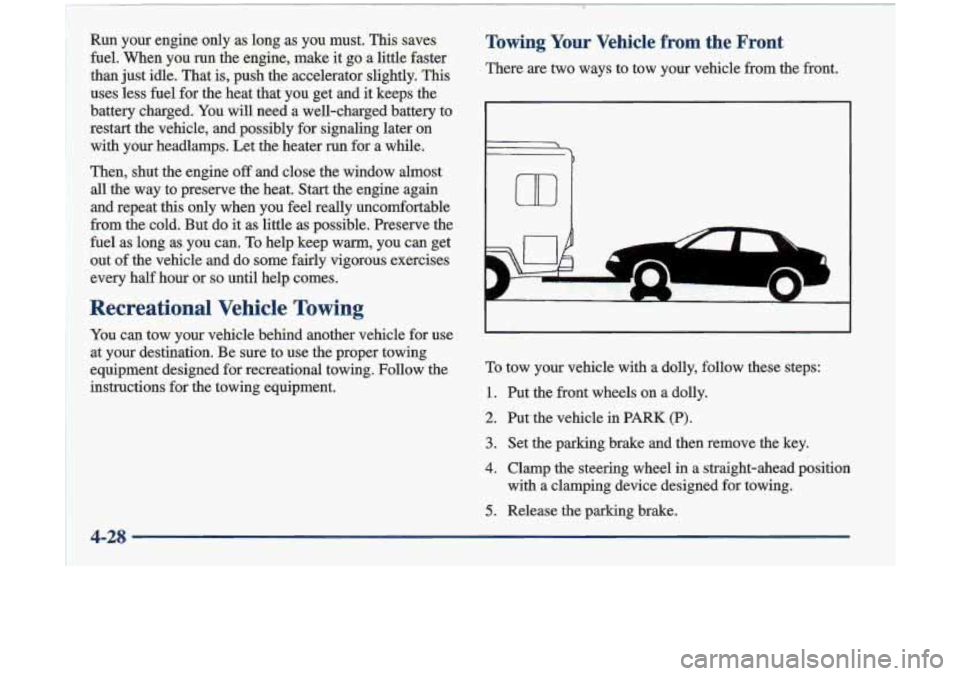
~~ ~ ~ ~~~~ ~ ~
~~~ ~ . ~~
-Run
your engine only as long as you must. This saves
fuel. When you run the engine, make it go a little faster
than just idle. That is, push the accelerator slightly. This
uses less fuel for the heat that you get and it keeps the
battery charged. You will need a well-charged battery to
restart the vehicle, and possibly for signaling later on
with your headlamps. Let the heater run for
a while.
' Then, shut the engine off and close the window almost
all the way to preserve the heat. Start the engine again and repeat this only when you feel really uncomfortable
from the cold. But do it as little as possible. Preserve the
fuel as long as you can. To help keep warm, you can get
' out of the vehicle and do some fairly vigorous exercises
.. every half hour or so until help comes.
Recreational Vehicle Towing
You can tow your vehicle behind another vehicle for use
at your'destination. Be sure to use the proper towing
equipment designed for recreational towing. Follow the
instructions for the towing equipment.
Towing Your Vehicle from the Front
There are two ways to tow your vehicle from the front.
To tow your vehicle with a dolly, follow these steps:
1. Put the front wheels on a dolly.
2. Put the vehicle in PARK (P).
3. Set the parking brake and then remove the key.
4. Clamp the steering wheel in a straight-ahead position
with a clamping device designed for towing.
5. Release the parking brake.
Page 183 of 348
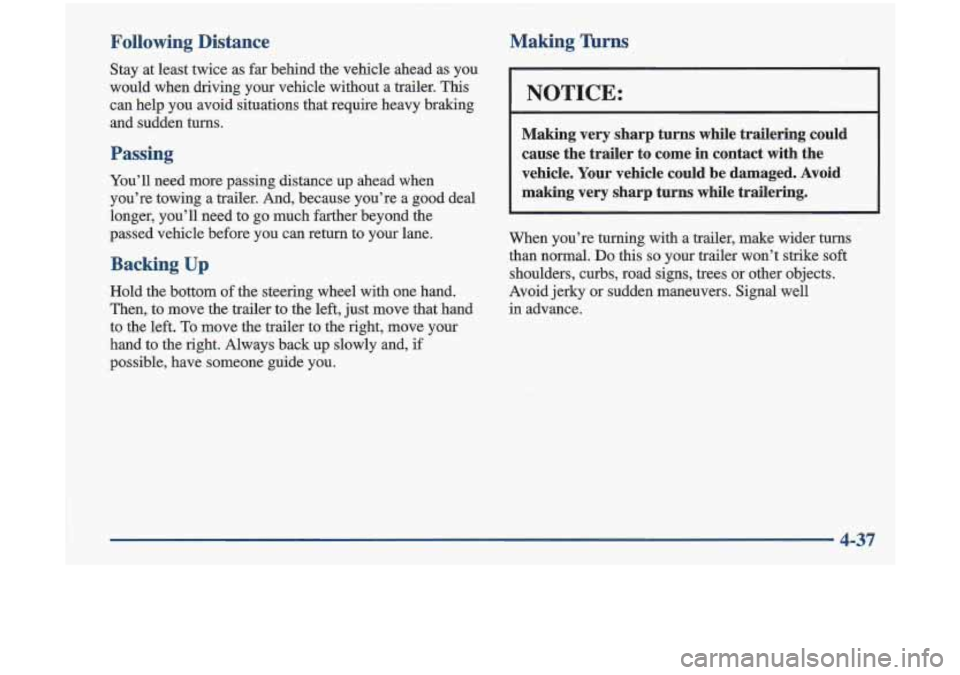
Following Distance
Stay at least twice as far behind the vehicle ahead as you
would when driving your vehicle without a trailer. This
can help you avoid situations that require heavy braking
and sudden turns.
Passing
You’ll need more passing distance up ahead when
you’re towing a trailer. And, because you’re a good deal
longer, you’ll need to go much farther beyond the
passed vehicle before you can return to your lane.
Backing Up
Hold the bottom of the steering wheel with one hand.
Then, to move the
trailer to the left, just move that hand
to the left.
To move the trailer to the right, move your
hand to the right. Always back up slowly and, if
possible, have someone guide you.
Making nrns
NOTICE:
Making very sharp turns while trailering could
cause the trailer to come in contact with the
vehicle. Your vehicle could be damaged. Avoid
making very sharp turns while trailering.
When you’re turning with a trailer, make wider tums
than normal. Do this so your trailer won’t strike soft
shoulders, curbs, road signs, trees or other objects.
Avoid jerky or sudden maneuvers. Signal well
in advance.
4-37
Page 208 of 348
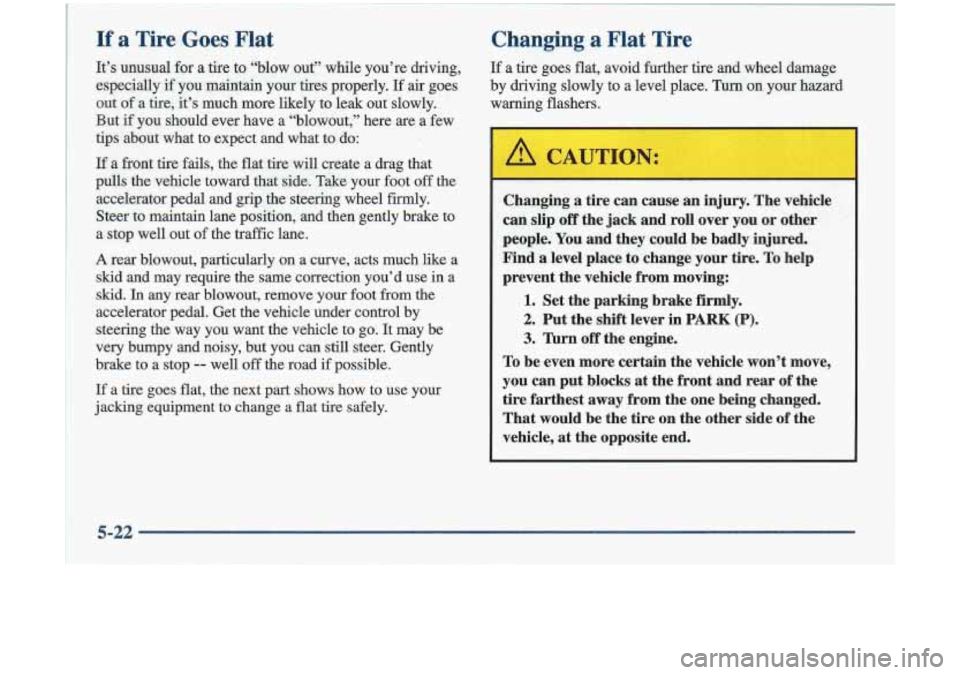
~~ ~. ~~ ~
If a Tire Goes Flat
It’s unusual
for a tire to “blow out” while you’re driving,
especially if you maintain your tires properly. If air goes
out
of a tire, it’s much more likely to leak out slowly.
But if you should ever have a “blowout,” here
are a few
tips about what to expect and what to do:
If a front tire fails, the flat tire will create a drag that\
pulls the vehicle toward that side. Take your foot off the
accelerator pedal and grip the steering wheel firmly.
Steer to maintain lane position, and then gently brake to
a stop well out of the traffic lane.
A rear blowout, particularly on a curve, acts much like a
skid and may require the same correction you’d use in a
skid.
In any rear blowout, remove your foot from the
accelerator pedal. Get the vehicle under control by
steering the way you want the vehicle to
go. It may be
very bumpy and noisy, but you can still steer. Gently
brake to a stop
-- well off the road if possible.
If a tire goes flat, the next part shows how to use your
jacking equipment to change a flat tire safely.
Changing a Flat Tire
If a tire goes flat, avoid further tire and wheel damage
by driving slowly to
a level place. Turn on your hazard
warning flashers.
:, , ,::*,,
Changing a tire can cause an injury. The vehicle
can slip off the jack and roll over you or other
people. You and they could be badly injured.
Find
a level place to change your tire. To help
prevent the vehicle from moving:
1. Set the parking brake firmly.
2. Put the shift lever in PARK (P).
3. ’krn off the .engine.
To be even more certain the vehicle won’t move,
you can put blocks
at the front and rear of the
tire farthest away from the one being changed.
That would be the’ tire on the other side of the
vehicle, at the opposite end.
5-22
Page 220 of 348

I NOTICE:
Spinning your wheels can destroy parts of your
vehicle as well as the tires. If you spin the wheels
too fast while shifting your transaxle back and
forth, you can destroy your transaxle.
Rocking Your Vehicle To Get It Out
First, turn your steering wheel left and right. That will
clear the area around your front wheels. Then shift back
and forth between REVERSE
(R) and a forward gear,
spinning the wheels
as little as possible. Release the
accelerator pedal while you shift, and press lightly on
the accelerator pedal when the transaxle is in gear. If
that doesn’t get you out after a few tries, you may need
to be towed out. If you do need to be towed out, see
“Towing Your Vehicle” in the Index.
~~
For information about using tire chains on your vehicle,
see “Tire Chains”
in the Index.
5-34
Page 335 of 348
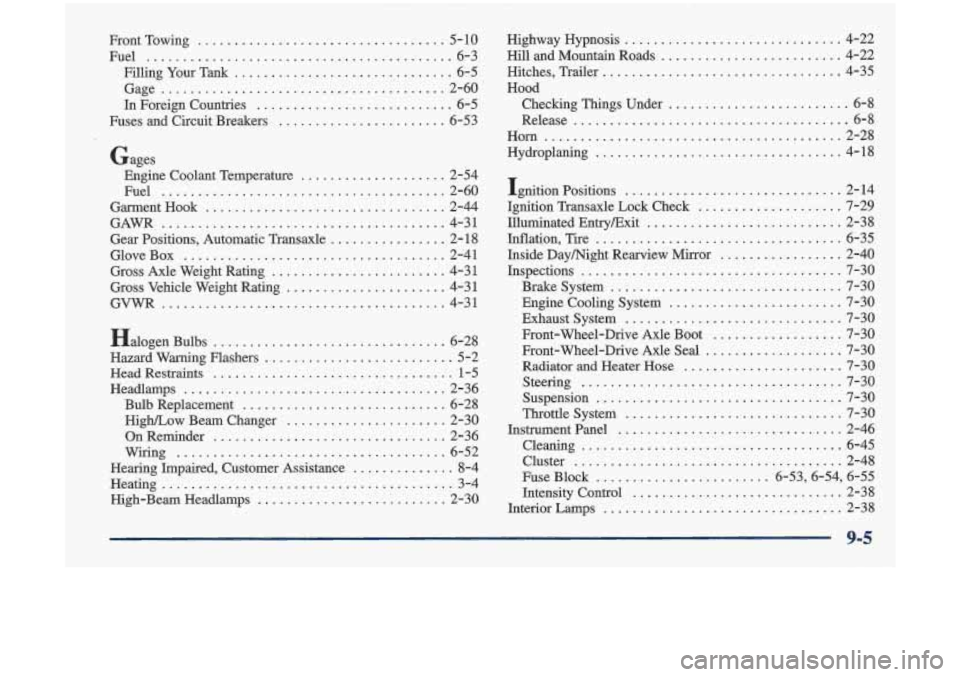
rrontTowing .................................. 5-10
Fuel
.......................................... 6-3
Filling
Your Tank .............................. 6-5
Gage
....................................... 2-60
In Foreign Countries
........................... 6-5
Fuses and Circuit Breakers
....................... 6-53
Gages Engine Coolant Temperature
.................... 2-54
Fuel
....................................... 2-60
GarmentHook
................................. 2-44
GAWR ....................................... 4-31
Gear Positions, Automatic Transaxle
................ 2- 18
GloveBox
.................................... 2-41
Gross Axle Weight Rating
........................ 4-31
Gross Vehicle Weight Rating ...................... 4-31
GVWR ....................................... 4-31
Halogen Bulbs
................................ 6-28
Hazard Warning Flashers
.......................... 5-2
Head Restraints
................................. 1-5
Bulb Replacement
............................ 6-28
High/Low Beamchanger ...................... 2-30
OnReminder
................................ 2-36
Wiring
..................................... 6-52
Hearing Impaired, Customer Assistance
.............. 8-4
Heating
........................................ 3- 4
Headlamps .................................... 2-36
High-BeamHeadlamps
.......................... 2-30 Highway Hypnosis
.............................. 4-22
HillandMountainRoads
......................... 4-22
Hitches. Trailer
................................. 4-35
Hood Checking Things Under
......................... 6-8
Release
...................................... 6-8
Horn ......................................... 2-28
Hydroplaning
.................................. 4-18
Ignition Positions
.............................. 2-14
Ignition Transaxle Lock Check
.................... 7-29
Illuminated EntryExit
........................... 2-38
Inflation, Tire
.................................. 6-35
Inside Daymight Rearview Mirror
................. 2-40
Inspections
.................................... 7-30
Brakesystem
................................ 7-30
Engine Cooling System
........................ 7-30
Exhaust System
.............................. 7-30
Front-Wheel-Drive Axle Boot
.................. 7-30
Front-Wheel-Drive Axle Seal
................... 7-30
Radiator and Heater Hose
...................... 7-30
Suspension
.................................. 7-30
Throttle System
.............................. 7-30
Instrumentpanel
............................... 2-46
Cleaning
.................................... 6-45
Cluster
..................................... 2-48
Fuse Block
........................ 6-53,6-54,6-5. 5
Intensity Control
............................. 2-38
Interior Lamps
................................. 2-38
Steering
.................................... 7-30
9-5
Page 340 of 348
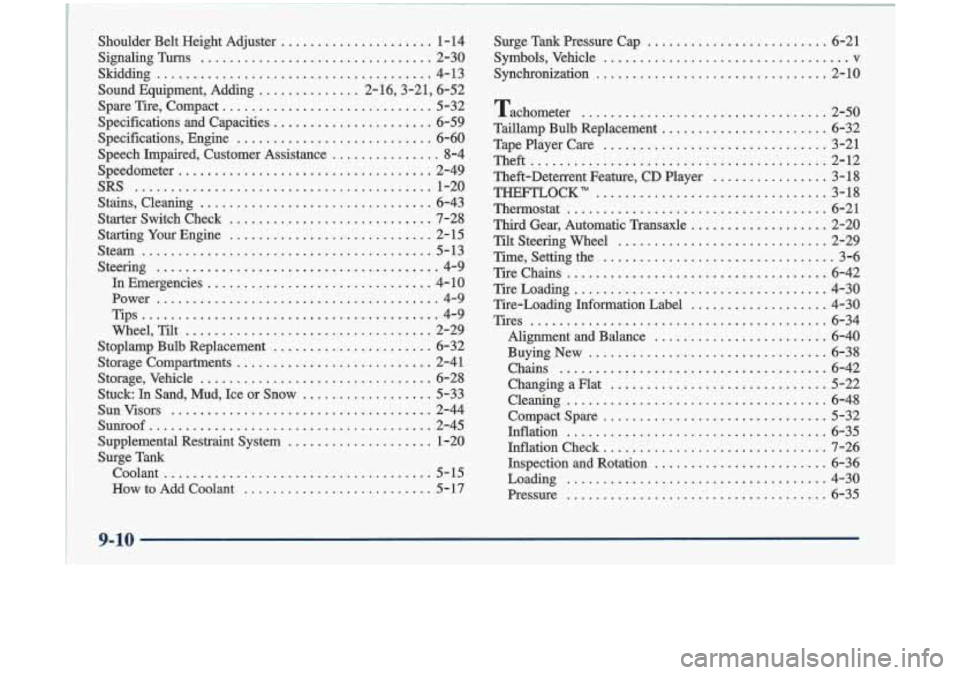
Shoulder Belt Height Adjuster ..................... 1-14
SignalingTurns
................................ 2-30
Sound Equipment, Adding
.............. 2-16,3-21, 6-52
Spare Tire, Compact
............................. 5-32
Specifications and Capacities
...................... 6-59
Specifications, Engine
........................... 6-60
Speech Impaired, Customer Assistance
............... 8-4
Speedometer
................................... 2-49
SRS
......................................... 1-20
Stains, Cleaning
................................ 6-43
Starter Switch Check
............................ 7-28
Starting Your Engine
............................ 2-15
Stem
........................................ 5-13
Steering
....................................... 4-9
In Emergencies
............................... 4- 10
Power
....................................... 4-9
Tips ......................................... 4-9
Wheel, Tilt
.................................. 2-29
Stoplamp Bulb Replacement
...................... 6-32
Storage Compartments
........................... 2-41
Storage, Vehicle
................................ 6-28
Stuck In Sand, Mud, Ice or Snow
.................. 5-33
SunVisors
.................................... 2-44
Sunroof ....................................... 2-45
Supplemental Restraint System
.................... 1-20
Surge Tank coolant
..................................... 5-15
How to Add Coolant
.......................... 5- 17
Skidding
...................................... 4-13
Surge
Tank Pressure Cap ......................... 6-21
Symbols. Vehicle
.................................. v
Synchronization ................................ 2-10
Tachometer
.................................. 2-50
Taillamp Bulb Replacement
....................... 6-32
Tape Player Care
............................... 3-21
Theft
......................................... 2-12
Theft-Deterrent Feature.
CD Player ................ 3-18
THEFTLOCK"
................................ 3-18
Thermostat
.................................... 6-21
Third Gear. Automatic Transaxle
................... 2-20
Tilt Steering Wheel
............................. 2-29
Time. Setting the
................................ 3-6
Tire Chains
.................................... 6-42
TireLoading
................................... 4-30
Tire-Loading Information Label
................... 4-30
Tires
......................................... 6-34
Alignment and Balance
........................ 6-40
Buying New
................................. 6-38
Chains
..................................... 6-42
ChangingaFlat
.............................. 5-22
Cleaning
.................................... 6-48
Compact Spare
............................... 5-32
Inflation
.................................... 6-35
Inflation Check
............................... 7-26
Inspection and Rotation
........................ 6-36
Loading
.................................... 4-30
Pressure
.................................... 6-35
9-10
I